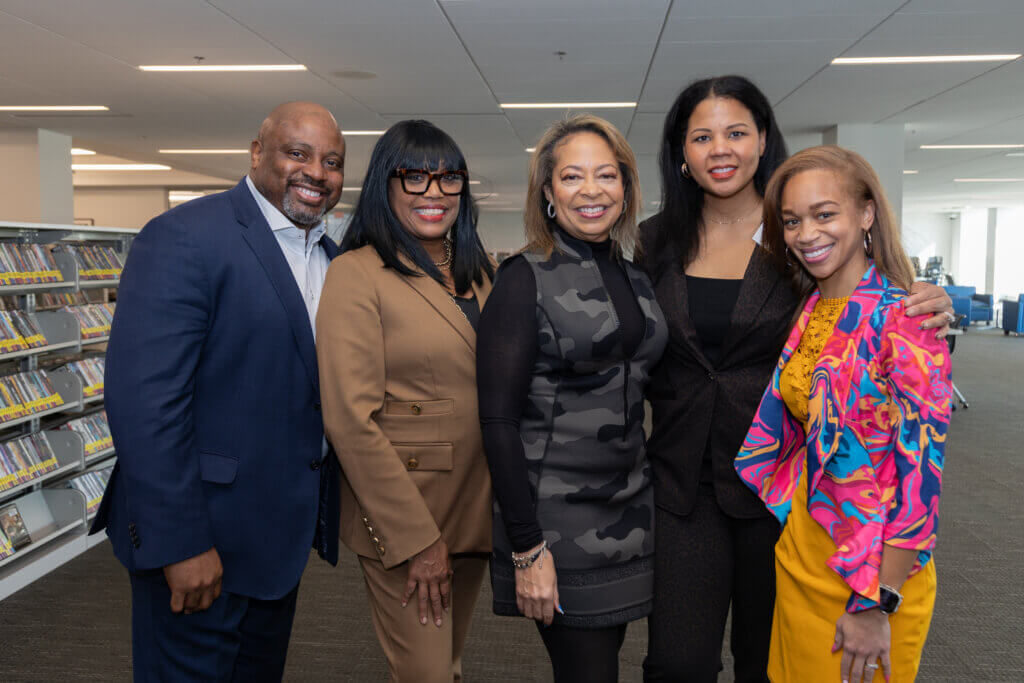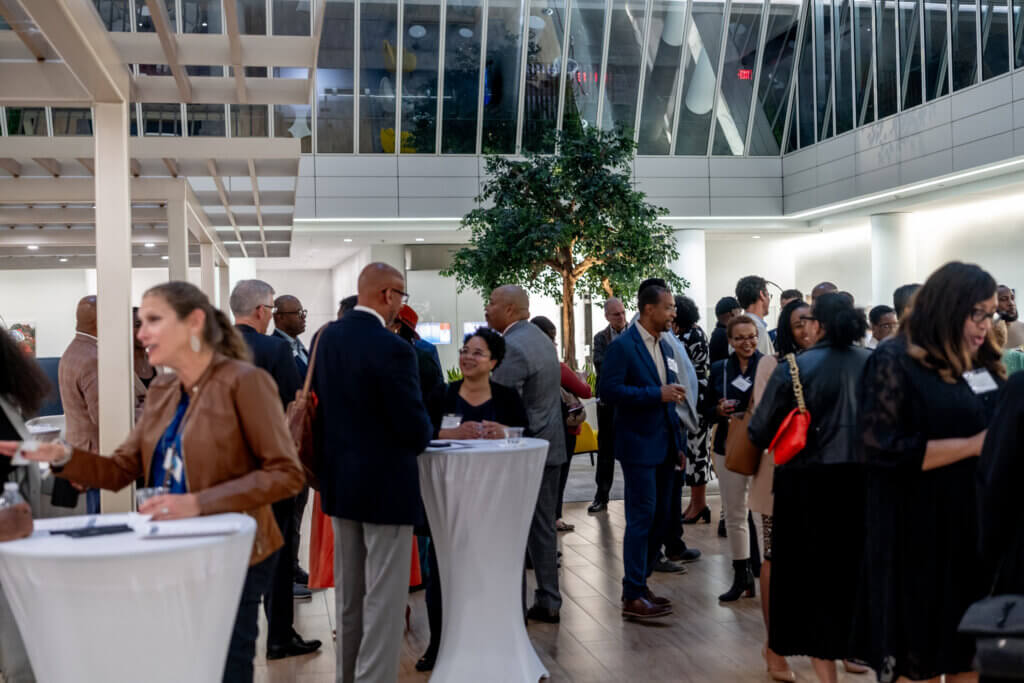The architecture, engineering, and construction (AEC) industry, like many, is greatly lacking in diversity, equity, and inclusion. White workers dominate these spaces, leaving Black professionals underrepresented and underpaid. That’s where Tia Perry, Executive Director at AEC Unites, comes in.
AEC Unites works to facilitate opportunities for Black professionals and Black-owned businesses. Under The Hard Hat’s contributing writer, Mariah Moore, sat down with Tia to discuss the racial disparity in the market, how AEC Unites is making an impact in the industry, and how we can achieve a more equitable future. This article is a short summary of the topics and questions covered over the interview.
The full interview is available to watch here:
UTHH: I would love to just start out by hearing a bit about your career trajectory. Where did you start, and how did you land at AEC Unites?
Tia: “I started in the association nonprofit space about 20 years ago, but I’ve recently found my passion for diversity, equity, and inclusion, and particularly within the architecture, engineering, and construction industries. I led DEI efforts early on for the Associated Builders and Contractors, starting back in 2015.
That experience really sparked my curiosity around creating equitable pathways, and eventually led to me transitioning to their full-time DEI director. Along the way, I discovered my love for working with minority contractors. Their creativity, resilience, and innovation constantly inspired me.
I also really fell in love with the workforce development side of the work. We often hear about the labor shortage in construction. But now that I’m involved in the space I’ve realized the amazing opportunities that are available. I feel like it’s my responsibility to share what I learned and pull others up as I continue to grow.”
UTHH: Speaking of AGC Unite, what is the mission?
Tia: “Our mission at AEC Unites is to provide intentional opportunities for Black talent and Black-owned businesses. We have two focus areas. Talent is the first one, and that’s diversifying the talent pipeline in architecture, engineering, and construction. The other side of the work is equipping and empowering Black-owned businesses in this space with the resources that are needed to win work. We work to curate connections and new business opportunities and to help them scale”

Tia Perry and the Turner Team.
UTHH: When was AEC Unites founded, and which areas does it serve?
Tia: “Conversations about AEC Unite started back in 2020, shortly after the murder of George Floyd. Our organization was founded by Deryl McKissack. I encourage you to Google Deryl and her family’s rich history in the architecture, engineering, and construction industries. AEC Unites by Deryl’s passion for using her network, industry peers, and resources to really drive positive change.
We officially launched in October of 2023. AEC Unites is fairly new. Our national office is located in Washington, D.C., and for now, we only represent the United States. But maybe someday that vision will grow internationally. Our office is located in D.C. and we have members all over the country.”
UTHH: We’d love to talk about specifically the disparity that we’re seeing in the industry. What does the disparity between Black and White professionals in AEC look like in pay or representation?
Tia: “Great question. The disparities between Black and White professionals, particularly in architecture, engineering, and construction, remain significant in terms of representation and compensation. As of 2023, Black or African-American individuals are amongst the most underrepresented group in architecture, making up approximately 1% of the architecture population.
In construction, Black workers held only 7% of all AEC jobs, even though they represented 13% of all workers. And so by contrast, White workers comprise 77% of the workforce, and hold 87% of all construction jobs, and 83% of architecture and engineering jobs.
As it relates to compensation disparities, in 2023, the median weekly earnings for Black workers stood at $967 compared to $1,157 for White workers. So, we are still plagued by the wage gap.
It remains top of mind for us as an industry that’s directly working to advance diversity, equity, and inclusion. There are several reasons for this difference. I think it comes down to education and experience, but there are still a lot of systemic barriers and a lot of discriminatory practices happening in construction.”
UTHH: What specifically does your role involve, and what does your day-to-day look like?
Tia: In my day-to-day, I wear a lot of hats, not necessarily a hard hat. But I’m a strategist, an advocate, a connector, an implementer. And my days range from meetings with members to support a project that they’re bidding on, or a meeting with a corporate partner who’s interested in learning more about AEC Unites, or maybe it’s navigating procurement.
Sometimes it’s mentoring students who are exploring careers in this space. I also lead strategy development. I oversee all the programming and ensure we’re moving our mission forward in measurable ways.”
UTHH: How exactly does AEC Unites facilitate opportunities for black professionals and black owned businesses?
Tia: “On the business side, we host pitch events-and we have several opportunities throughout the year for our members to showcase their work. One of the great highlights of my career was facilitating a black business mixer during Construction Inclusion Week last October. We gave six of our members the opportunity to pitch their businesses, and we invited the key industry to listen to hear about their capabilities.

AEC hosted event.
We also elevate supplier diversity best practices and connect firms with contracting opportunities. So when an organization joins AEC Unites that’s a minority owned firm, we work to highlight their capabilities, and we dedicate a marketing campaign to elevate their brand and showcase the value they bring to the industry.
One of the things I’m most excited about is our Opportunity Hub, set to launch in July. It will serve as a centralized online platform where our members can log in to discover upcoming projects and opportunities in the pipeline.
We’re also partnering with Historically Black Colleges and Universities to support the next generation of AEC professionals. Currently we have two partnerships, one with Florida A&M University and Prairie View A&M University. As part of these partnerships, we formed a focus group with the students enrolled in ACE-centered majors. We sat down for an informal conversation to better understand how we can support their growth.”

Focus group hosted by AEC Unites.
UTHH: For companies that are looking to be more inclusive, or if they have a new DEI initiative, what’s one concrete step you recommend that they take?
Tia: “I would start with intentionality. I think a lot of folks get caught up in saying that they’re advancing DEI, with a statement on our website and a pledge. But is it integrated in every facet of your organization? Is it part of your safety culture? Are you people really embodying an inclusive culture?
Give it the support that it needs and the resources, whether that’s a budget or a full-time person, even in today’s climate, you may have to pivot in some capacity but continue the work. Be intentional with your impact, your resources, and if you’re not sure where to start you can join AEC Unites.”
UTHH: What advice would you give to a young Black professional looking to get into the AEC space?
Tia: “There are tons of resources out there. We have a talent resource center on our website. Right now, it has internships and financial aid resources and the resources are growing by the week. But I would start by finding a mentor. If you’re in high school, ACE Mentor is an amazing resource. They’re an MOU partner of AEC Unites.
I would also add to do your own research, because every industry has its own set of misconceptions. Oftentimes, it relates to construction and the misconceptions that it is a dirty industry. And there’s an innocent ignorance about the technology, the BIM, the innovative careers in construction. The industry has so much to offer. There is literally something for everyone. So just be open-minded, keep working hard, and just utilize the resources that are out there.”
UTHH: Is there anything else you would like to share about the mission?
Tia: “I would say that AEC Unites will continue to move the needle forward as it relates to advancing DEI. I know that the current political climate is challenging for many organizations that support DEI, particularly those involved in federal work because of the current Executive Orders. However, pivot but continue the work. Whatever that means to your company culture.
I would encourage them to join AEC Unites and support us and the work that we do. We’re impacting lives. We are supporting students. We empower and help scale minority-owned businesses and the work’s going to continue.
I would just say lean in and help us make the world a better place. As cliché as it sounds, but I mean, literally it is. We’re making the industry a better place.”
Thanks to Tia for taking the time to speak with Mariah and Under the Hard Hat about such an important topic. Learn more about AEC Unites here, and connect with their company page on LinkedIn.
If you’d like to hear more from industry leaders discussing architecture, engineering, and construction, subscribe to the newsletter and follow us on LinkedIn!



1 comment